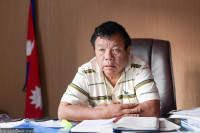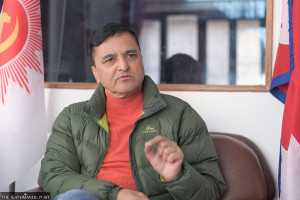Interviews
Jurgen P Kropp: It’s imperative to focus on building infrastructure that are climate-resilient
German scientist on Nepal’s vulnerability to a changing climate and what it can do to mitigate and adapt to the new normal..jpg&w=900&height=601)
Chandan Kumar Mandal
Climate change is one of the biggest emergencies of our generation. While its impacts are felt across the globe, small-islands nations and mountainous countries like Nepal are most vulnerable. Nepal is ranked as the fourth most vulnerable countries in the world when it comes to the effects of climate change. Yet its share of carbon emission is negligible. While adverse impacts of climate change could be felt across various sectors, small mountainous countries like Nepal, which is hardly prepared to respond to the climate crisis, is likely to experience even harsher future. The Post’s Chandan Kumar Mandal caught up with Prof Jurgen P Kropp, a senior climate change scientist with the Potsdam Institute for Climate Impact Research, a German government-funded research institute working in the field of global change, climate impacts, and sustainable development, to discuss what Nepal needs to do to deal with climate change and how it can become a climate-resilient country.
This interview has been condensed for clarity.
How severe will be the effects of a changing climate for a mountainous and least developed country like Nepal?
Nepal is one of the most vulnerable countries and there are various dimensions to this. It is obvious that temperature will further rise and have an impact on glaciers and Himalaya mountains where there are some instances of glaciers melting. But this is not the issue only for people here in Nepal. This is an issue for all people in Asia because big rivers are fed by Himalayan glaciers, which function as water towers for the whole region. Then there is another point which is rather unclear—how will the infrastructure be affected by these extreme events since they are always singular events? It will be difficult to predict, for example, what happens when an extreme rainfall will take place.
How we approach the monsoon is also fundamental. Normally, monsoon approaches in spring which is followed by 60-70 consecutive days of heavy rain. But Nepal seems to be coping up quite well. Our models show monsoon is going to get interrupted more often. It will start at the normal time, rain for 30 days and then will stop for a week or two. This will have a tremendous impact on water balance and water harvesting strategy.
Then how is Nepal to start its climate change actions? What should be the priority sectors, to begin with?
It has to start with critical infrastructure. What is your electricity or grid, for instance? Is it in a shape that you can always ensure that there will be electricity supply in case of an extreme disaster, heavy rain, or landslides? This is one point. Then there is transport infrastructure. If the disaster occurs in one place, which is far away from Kathmandu, are responders able to reach there easily or do they need helicopters? These are important points. Disaster resilience and disaster relief are very important. Climate change is happening so it’s imperative to focus on building climate-resilient infrastructure.
Is it likely that natural resources, freshwater resources and livelihoods will get more affected than others?
When you talk about melting glaciers, this is an effect which probably has the largest impact beyond 2050 if not beyond 2080. But glaciers are extremely important because they impact freshwater availability. For instance, if you look at big rivers like Ganga, it could happen that in the next 50, 60 or 70 years, it could turn into a seasonal river—flowing only during the torrential rainy season—because all the glaciers will have disappeared.
This scenario might hold true for Nepal too where small glaciers feed rivers.
Possibly then, Nepal might have to develop even more advanced technologies to measure water harvesting, runoff harvesting and rainwater harvesting. This is in the long run. On a short time horizon, Nepal will have to do increasingly experience an extreme event such a heavy rainfall or a drought.
But since Nepal is rich in water resources, it need not worry so much right now. The country is quite green in comparison to other areas on the planet, too. Yet, it could become a problem in the future when all the freshwater from the alpine region or Himalayan region will disappear. Then Nepal will also have to convert the fossil fuel economy to a renewable energy economy. This is mandatory for all countries. There is no way out of it.
Climate-induced disasters are likely to cause multi-sectoral damage. So how can Nepal foster resilience to climate change?
Nepal should invest in the future. A circular economy, for example, will be an investment in the future because it reuses materials and also opens the way we look at the entire value chain. To foster resilience, we have to include a price for environmental damage. Nepal can invest in advanced mobility which doesn’t create pollution load. It can also invest in better production of brick kilns which is a big problem here. We can make infrastructure resilient to save against landslides, heavy rain and that’s an investment into the future.
There was an instance of climate change-induced migration in a district in Mustang. There are also instances of dying of natural springs in mid-hills. What can be done to stop such climate-induced migration in the future?
There are signs that changing environmental conditions can force migration. So Nepal is not the only place where it can take place. However, it is still difficult to clearly relate the movement of people owing to climate change because it is a gradual process. People’s decision to leave home is a short term decision. So there will be various push and pull factors.
At the same time, it's also important to ensure safe usage of environmental resources. So when people overuse water, for instance, springs are bound to dry. In most of the cases, at the moment, at least, we can say dry springs are caused by overuse. But in the future climate change will exacerbate such effects. Meaning, one needs to have to think about both human usage and climate change making it difficult to track the root cause for the migration.
Nepal has been at the receiving end when it comes to impacts of climate change despite its negligible contribution to global warming. How should international communities or developed countries help countries like Nepal?
This is an enduring story which has been discussed for more than 20 years now. We started it as a Conference of the Parties (COP) process. For example, the two-degree Celsius threshold was introduced by the German government during the first climate change conference. It needed more than 20 years before it was internationally accepted. This shows how long it takes to incorporate science-based knowledge into policymaking. Coming to having a fair share of burden, I still see some problems. In principle, it is accepted that we need the Green New Deal. The Deal also means that we include prices for environmental damage so that we come to fair burden agreement wherein the countries which are suffering most from environmental impacts are to some extent compensated by the richer countries. But we also need to develop new ways to measure the GDP and human welfare.
One of the outcomes of climate negotiations was the Green Climate Fund which is located in South Korea. The plan was for advanced economies to jointly mobilise $100 billion per year by 2020. There has been progress, but it’s still short of the $100 billion mark. This is because many countries think that they can solve problems arising to climate change on their own. But that is ignorant since climate change is a global problem. We need to come back to the multilateral order because cooperation is the only way forward. It is also scientifically proven that responsibility and cooperation enable us to solve the problem—not the other way around.
Nepal recently received its first Green climate fund support. What are the areas that Nepal should prioritise while seeking international support for climate actions?
A country should ensure a decent life for its people. This decent life should be developed sustainably. But is it not so simple. Water issue is a case in point. I had gone to Dhulikhel during my last visit and found that the landscape is fragmented. Buildings are all around, and in between, there is agriculture land. There is a need to move forward with planning because land is an asset that helps one regulate the climate even locally.
We now know that the Amazon rainforest triggers its own precipitation. This implies that we need to take care of forest, ensure its useability for people dependent on it and so on. You have to look at the stability of the slopes because Nepal adheres to the long-lasting tradition of doing agriculture on terraces. Also, Nepal has to bear the pressure of a growing population and produce more food. So it would be prudent to use land in a sustainable manner. You have to create adequate warning infrastructure for extreme events like glacial outburst, for example. These are a few areas. Then the country also needs to develop an economic basis for people living in high mountains because they are threatened the most in parallel to the people living in the lowlands.
Climate change is posing a non-traditional security threat. What does it take for everyone to recognise it as a threat and how can we include these discussions in policy circles?
Education is key. Even in Germany, we have climate change deniers. You can solve it by technological innovation and individual behavioural changes. In order to do so, you have to educate people. You have to convince them that the standard way of living is no longer sustainable and threatens the livelihood conditions of everyone on this planet. The poor are more vulnerable than the rich. Therefore, there needs to be a collective vision for human lives on the planet with more cooperation.
***
What do you think?
Dear reader, we’d like to hear from you. We regularly publish letters to the editor on contemporary issues or direct responses to something the Post has recently published. Please send your letters to [email protected] with "Letter to the Editor" in the subject line. Please include your name, location, and a contact address so one of our editors can reach out to you.




 6.12°C Kathmandu
6.12°C Kathmandu













